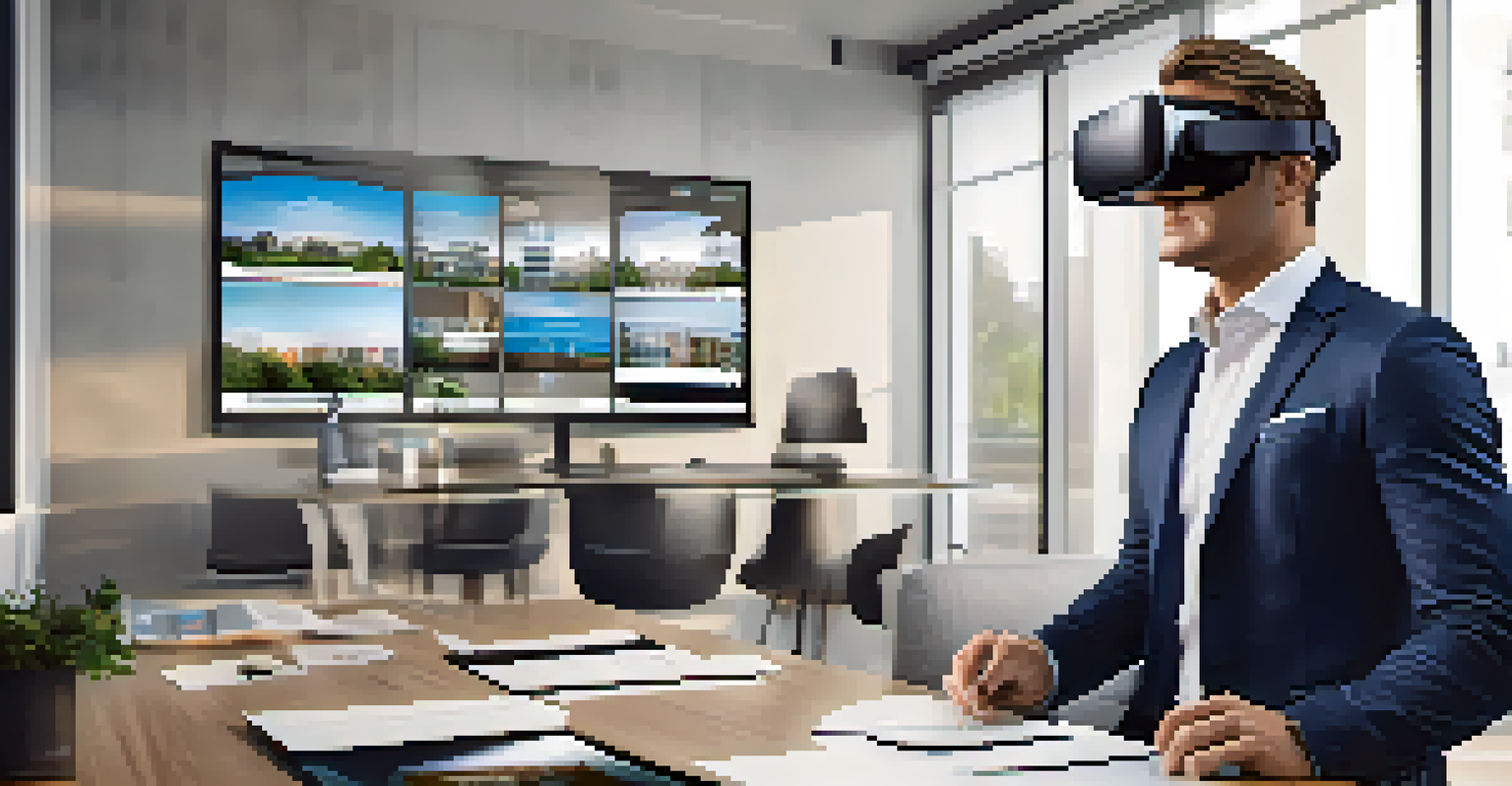The Future of Real Estate: Trends in Virtual Property Tours

The Rise of Virtual Property Tours in Real Estate
In recent years, virtual property tours have become a game-changer in real estate. With technology advancing rapidly, buyers can now explore homes from the comfort of their couch. This trend has gained traction especially during periods when in-person visits were limited, allowing potential buyers to browse properties at their convenience.
Technology will continue to transform the way we buy and sell real estate, providing opportunities that were once unimaginable.
These immersive experiences not only save time but also broaden the market reach for agents. Imagine being able to showcase a stunning beachfront property to a family living thousands of miles away. Virtual tours have made this possible, breaking geographical barriers and expanding opportunities for both buyers and sellers.
As we move forward, the demand for virtual tours is expected to rise even more. Buyers are increasingly looking for convenience and flexibility, and virtual tours deliver just that. It’s clear that this trend is here to stay, shaping the future of the real estate industry.
Benefits of Virtual Tours for Home Buyers
For home buyers, virtual tours offer several compelling advantages. One of the most significant benefits is the ability to view multiple properties in a short timeframe. This efficiency allows buyers to make more informed decisions without the pressure of in-person visits.

Additionally, virtual tours provide a level of comfort and privacy that traditional viewings may lack. Buyers can explore at their own pace, revisiting areas of interest or taking a closer look at features that catch their eye—all without the feeling of being rushed by an agent.
Virtual Tours Transform Real Estate
Virtual property tours have revolutionized the buying and selling process, allowing users to explore homes conveniently from anywhere.
Lastly, the use of virtual tours can help buyers get a better sense of a property's layout and flow. It’s one thing to see pictures online, but experiencing a 3D walkthrough can significantly enhance their understanding of how spaces connect. This clarity can lead to more confident purchasing decisions.
How Virtual Tours Enhance the Selling Process
For sellers, virtual tours can be a powerful marketing tool. By showcasing a property through a virtual tour, sellers can attract more potential buyers and stand out in a crowded market. An engaging presentation can make a lasting impression, prompting interested parties to reach out for more information.
Virtual reality is the next big thing for real estate. It allows buyers to experience properties in a way that was never possible before.
Moreover, virtual tours can reduce the number of unnecessary in-person showings. When buyers have the opportunity to explore a home virtually, they can determine if it meets their needs before scheduling an actual visit. This can save time for both sellers and agents, leading to a more streamlined selling process.
Additionally, incorporating virtual tours into listings can enhance overall online visibility. Properties with virtual tours often receive increased engagement, leading to higher chances of selling quickly and at a better price. It's a win-win situation that benefits everyone involved.
Technological Innovations Driving Virtual Tours
The backbone of virtual property tours lies in innovative technology. Tools such as 360-degree cameras and virtual reality (VR) headsets have revolutionized how properties are showcased. These technologies allow for highly interactive experiences that can simulate walking through a home.
Moreover, advancements in software have made it easier for agents to create and share virtual tours. User-friendly platforms enable realtors to build tours without needing extensive technical skills. This accessibility encourages more agents to adopt virtual tours as part of their marketing strategy.
Efficiency for Home Buyers
Buyers can view multiple properties quickly and comfortably, leading to more informed decisions without the pressure of in-person visits.
As technology continues to evolve, we can expect even more enhancements in virtual tours. Features like augmented reality (AR) could allow buyers to visualize how their furniture would fit into a space, further personalizing the experience and enhancing decision-making.
The Role of Virtual Tours in Luxury Real Estate
In the luxury real estate market, virtual tours are proving to be especially beneficial. High-end properties often attract a global clientele, and virtual tours allow these buyers to explore homes in different countries without the need for travel. This accessibility is crucial in a market where time is often of the essence.
Luxury listings can benefit from high-quality virtual tours that highlight unique architectural features and lavish amenities. The ability to showcase a property’s exclusivity through an engaging digital experience can be a significant selling point. Potential buyers can appreciate the details and craftsmanship that make a luxury home special.
Ultimately, virtual tours are becoming an expectation in the luxury market. Buyers are increasingly seeking convenient ways to explore upscale properties, and agents who embrace this trend can gain a competitive edge. It's clear that virtual tours are reshaping how luxury real estate is marketed and sold.
Challenges and Limitations of Virtual Property Tours
While virtual property tours offer numerous benefits, they also come with challenges. One of the primary concerns is the potential lack of personal interaction. For many buyers, the relationship with their agent can be crucial in the home-buying process, and virtual tours can sometimes feel impersonal.
Additionally, not all properties translate well to virtual formats. Certain features, such as neighborhood vibes or the feel of a community, are difficult to convey through a screen. Buyers may still want to visit a property in person to get a true sense of what it offers.
Challenges of Virtual Tours
Despite their benefits, virtual tours may lack personal interaction and can struggle to convey certain property features effectively.
Finally, technical issues can sometimes arise, impacting the user experience. Slow internet connections or poorly designed tours can frustrate potential buyers. Ensuring high-quality and user-friendly virtual tours is essential to maximize their effectiveness and appeal.
The Future Landscape of Real Estate with Virtual Tours
Looking ahead, the integration of virtual tours in real estate is likely to become even more pronounced. As consumer preferences shift towards digital solutions, real estate professionals will need to adapt to remain competitive. This means embracing technology and using it to enhance the buying and selling experience.
Moreover, we can anticipate further advancements that will make virtual tours even more immersive. Features like live virtual open houses, where agents can interact with potential buyers in real-time, could emerge, blending personal interaction with the convenience of virtual tours.

In conclusion, the future of real estate is undoubtedly intertwined with virtual property tours. As technology continues to evolve and become more accessible, it will reshape how we buy and sell homes, creating new opportunities and experiences for everyone involved.